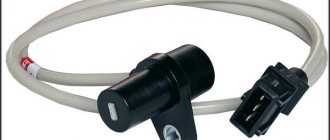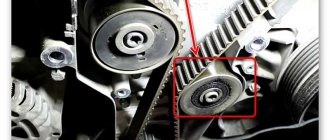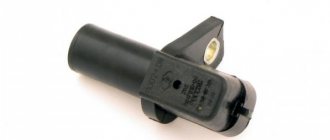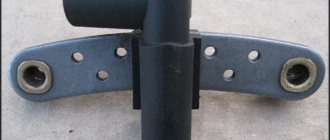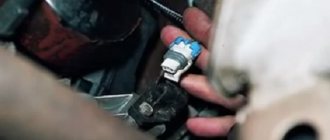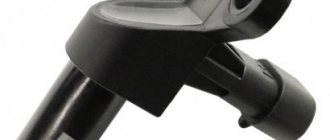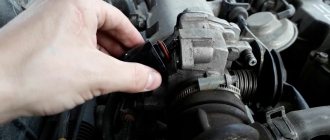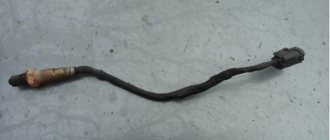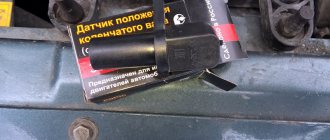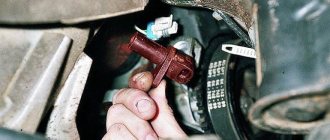Almost all modern engines are stuffed with various electronics and sensors that are needed to control the engine and much more. Currently, there are fewer and fewer cars with simple carburetor engines that had virtually no electronics. They were replaced by powerful and economical engines capable of reaching high speeds, but the maintainability of these cars was gone. The difficulty of finding a breakdown and the variety of number of sensors make troubleshooting very difficult and time-consuming, but if you connect special equipment to the car, then everything immediately becomes clear.
There are a lot of such sensors in the Chevrolet Cruze, but if they break down, there are sensors that the car can continue to move independently until service, and there is one sensor called the crankshaft position sensor (CPS), without which the car’s engine will not even start.
This article talks about the crankshaft sensor on a Chevrolet Cruze, namely, issues related to its breakdowns, locations, as well as self-replacement, cost and much more.
What is the crankshaft sensor for?
The first thing you should understand is that without a crankshaft sensor on a Chevrolet Cruze you won’t be able to go anywhere. This is the only sensor in the car, without which it is simply impossible to start the engine. It is also sometimes called a timing sensor. This is because this particular part allows the electrical controller to synchronize its work with the car’s gas distribution system, thereby controlling the ignition system and fuel injection.
In fact, this system is quite simple and consists of creating specialized inductive pulses or signals. At the moment when the teeth of the crankshaft pulley cross the line of the core, electrical impulses occur. That is, it is an electromagnetic element capable of synchronizing the operation of injectors in the fuel system.
Hall Sensor
A Hall sensor is a non-contact device that operates on a constant magnetic field. In a Volkswagen Golf it is located on the left under the camshaft pulley. To get to the Hall sensor, you will need to remove the boot and unfasten two latches.
The Hall sensor monitors two parameters at once - the speed and position of the gear rotor. Due to the presence of a magnetic field, the device can accurately determine the position of the tooth and rotor cavity simultaneously.
If the camshaft pulley is heavily worn, the sensor gives a command because it reads signals that differ from normal about the position and rotation of the gear rotor.
The sensor is connected directly to the pulley and operates without power on an electromagnetic field
Since the location of the Hall sensor is related to the operation of the camshaft, if it breaks, it will take a long time to replace it. It is recommended to replace the sensor at a service center in order to avoid mistakes in tensioning the belts and finding marks for correct alignment of the shaft positions.
Video: replacing the hall sensor on a 1993 Volkswagen Golf 3
Main reasons for failure
The main reasons for failure of the crankshaft sensor include:
- Natural wear and tear. The sensor is installed on the engine in the flywheel area. During the operation of a car, it is exposed to high temperature changes, as a result of which its structure can receive microcracks into which liquids and oils enter, which leads to corrosion.
- Contamination of the working surface with metal shavings. This process significantly reduces the sensitivity of the sensor and can lead to signal loss. As a rule, this reason occurs on “older” cars. In most cases, cleaning the working surface of the sensor is not successful.
- Mechanical damage. Such a malfunction is most likely the result of incorrect installation, replacement with a sensor from another engine modification, or a traffic accident.
- Broken electrical wiring or destruction (corrosion) of the sensor connector.
The true reason for the failure of most crankshaft sensors is the destruction of the electromagnetic sensor. It represents an inductor wound around a core of magnetic material. The winding is made of a very thin copper conductor in varnish insulation. As a result of repeated heating and cooling of the sensor, the thinnest conductor can receive a micro-rupture. As the sensor heats up, the coil breaks, the sensor stops working, the car stalls, then cools down, the coils close again and the engine can start again. In such a situation, experienced car enthusiasts place a rag soaked in cold water on the sensor. This way you can get to the parking lot or repair site.
Reasons for sensor failure
Although the DPKV is a fairly reliable sensor, breakdowns still occur. The main reasons for these breakdowns:
- Natural wear consists of damage to the windings inside the sensor or its magnetic core; such damage often occurs due to aging of the sensor;
- Mechanical damage occurs when replacing the clutch or when carrying out any other work inside the sensor, as well as due to an accident;
- Contamination of the magnetic part of the sensor with various types of debris, such as metal shavings, etc.;
- Oxidation of the sensor connector occurs due to moisture or other technical liquids entering it;
Recommendation
Since the crankshaft sensor is one of the main sensors in the Chevrolet Cruze engine control system, some car enthusiasts purchase this sensor for future use, especially if they travel long distances to sparsely populated areas.
Damage to the crankshaft sensor is a critical problem in the Chevrolet Cruze. The sensor has a limited resource. You start having problems with it after 7 - 10 years of using the car.
The sensor is one of the main sensors of a set of engine management accounting programs. Designed for general synchronization of the operation of a complex of accounting programs for vehicle ignition and fuel injection. The main task of the sensor is to monitor the angular position of the vehicle's crankshaft. In most cars, like the Chevrolet Cruz, this task is solved with the help of special teeth (teeth) attached to the flywheel. At one time the teeth of the crankshaft rotate, the flywheel rotates synchronously with it. Passing in the area of the electrical sensor, they induce electronic impulses.
in our VKontakte group
DIAGNOSE YOUR CAR YOURSELF!
The 58X control signal is generated by the crankshaft position sensor. During one revolution of the crankshaft, 58 pulses are produced. The ECM uses the 58X reference signal to calculate engine speed and crankshaft position. The ECM continuously monitors the number of pulses in the 58X reference signal circuit and compares them with the received crankshaft position signal pulses.
Condition for the DTC to Occur
Conditions for setting the DTC.
The minimum crankshaft position sensor signal voltage is less than 1.3196 V. or the maximum crankshaft position sensor signal voltage is greater than 2.3998 V. or the difference between the minimum and maximum crankshaft position sensor signal voltage is greater than 0.3617.
Action Taken When the DTC Sets
The malfunction indicator lamp lights up. The controller records the operating conditions at the time the fault is detected. This information is stored in a status record buffer and fault logs. An archive of diagnostic trouble codes is saved.
Conditions for Clearing DTC/Malfunction Indication
The malfunction indicator lamp turns off after three consecutive test cycles have completed without failure. The historical DTC clears after 40 heat cycles without failure. The DTC can be cleared by a scan tool.
Diagnostic guidelines
An intermittent fault may be caused by a loose connection, chafed insulation, or broken wiring under the insulation. Check: Loose Connection - Check the ECM wiring harness and connectors for loose connections, faulty locks, bent or damaged terminals, and loose terminal-to-wire connections. Harness damage - Inspect the wiring harness for damage. If the harness appears to be OK, disconnect the ECM, turn the ignition switch ON, and observe the voltmeter reading on test circuit 58X by moving the ECM-related connectors and harnesses. Changes in signal level will indicate the location of the fault. Review the mileage of fault records as failed diagnostic tests will help evaluate the conditions under which the DTC was set. This will help diagnose the conditions.
Crankshaft sensor failure is a critical malfunction of the Chevrolet Cruze. The sensor has a limited resource. As a rule, problems with it appear after 7–10 years of vehicle operation.
Replacing the sensor
When purchasing a crankshaft sensor for a Chevrolet Cruze, you should pay attention to its markings (part number). For engines with a volume of 1.8 l F18D4, the original part number from General Motors is 55567243. The sensor for engines HR51S, HR52S (analogue) has part number 33220-80G00. Its price is about 1,500 rubles.
When purchasing a sensor, it is better to have an original spare part in order to check the exact fit of the mounting dimensions. There are cases of purchasing Chinese “dummies” on the market, that is, sensors without electronic “internals”.
The sensor is located in the engine flywheel area. The replacement process is simple and takes a few minutes. The sensor is attached to one bolt. After replacing the crankshaft sensor, re-diagnosis of the engine and resetting (deleting) errors is required.
Chevrolet Cruze. Engine crankshaft sensor malfunctions
Crankshaft sensor - signs of malfunction
First, it is necessary to highlight the most understandable and obvious signs of crankshaft sensor malfunctions:
1. A noticeable detonation occurs in the engine under dynamic loads;
2. At idle speed there are signs of instability;
3. Engine power is significantly reduced without any indications on the instruments;
4. During direct driving, the dynamics of the car are significantly reduced. However, this problem may indicate problems with the engine itself;
5. Uncontrolled decrease and increase in speed.
In addition, the fact that the crankshaft position sensor has become unusable and faulty can be indicated by the banal inability to start the car engine. Therefore, a car enthusiast does not need to be a professional in various issues about the design of electronic car systems in order to identify and determine a malfunction.
Symptoms of a faulty crankshaft sensor
One of the obvious signs of DPKV problems is a complete engine stop. This happens as a result of the fact that malfunctions in its operation do not allow the power system to supply fuel in a timely manner, and the ignition system is not capable of igniting the fuel-air mixture at a given moment. Now let's look at why this happens.
The crankshaft sensor sends signals to the ECU indicating the position of the crankshaft at a certain moment, and also reports the direction of rotation of the shaft and indicates the rotation speed. Please note that on different cars, both the device itself and some functions of the DPKV may differ. This depends on the type of element installed. Devices can be:
-magnetic inductive type; - Hall effect sensors; -optical sensors;
The electronic control unit receives signals from the specified device, thanks to which the controller “knows” the position of the crankshaft in relation to TDC in the first and fourth cylinders, and also records the frequency and direction of rotation of the shaft. Based on this data, the block generates signals to control the ignition timing, creates control pulses for injection nozzles, controls the operation of the fuel pump, etc.
Crankshaft position sensor: signs of malfunction and checking the sensor
If the cause of the problem is the crankshaft sensor, symptoms of a malfunction may be as follows:
- a cold or warm engine does not start; -during operation under load, detonation occurs; - idle speed fluctuates; - engine power decreases, dynamics disappear; - the speed jumps while driving, the speed changes randomly, etc.
These symptoms may also appear as a result of other malfunctions. For this reason, before starting manipulations with DPKV, other possible problems should be excluded. It should also be added that malfunctions of the crankshaft sensor may not occur all the time. In other words, unstable operation of the internal combustion engine or problems with starting may not always appear, although the “check” lights up. In this situation, it is recommended to perform computer diagnostics of the car engine to more accurately determine the cause.
"> / opel astra-j,mokka,insignia,zafira-c 1.6/1.8 xerchevrolet aveo,cruze 1.6/1.8 09
"> / opel astra-j,mokka,insignia,zafira-c 1.6/1.8 xerchevrolet aveo,cruze 1.6/1.8 09
Speed sensor used Chevrolet CRUZE sedan (J300) (2009 - 2021) on cars from disassembly
Found an error in the compatibility of a spare part with a car? Report it to our specialists.
AutoPro experts know additional configurations:
- Crankshaft position (revolution) sensor standard equipment: 6238868, 55567243, 55567243, 550830, 55571977, 0261210325, 261210325, 550721, 0902283
This spare part depends on the Chevrolet Cruze engine and its modifications
- 1.6 F16D4, 1.8 [2H0, F18D4]: 6238868, 55567243, 55567243, 550830
- 1.7 Diesel LUD: 55571977, 0261210325, 261210325, 550721, 0902283
The spare part Crankshaft position (revolution) sensor is suitable for cars:
- Chevrolet: Cruze sedan (J300) , Orlando minivan (J309) , Cruze hatchback (J300) , Trax SUV , Cruze station wagon (J300)
- Opel: Insignia sedan (G09) , Insignia hatchback (G09) , Insignia station wagon (G09) , Astra hatchback , Astra station wagon , Zafira minivan (P12) , Astra hatchback , Mokka SUV , Astra sedan
Where is the sensor located?
In order to understand exactly where the crankshaft sensor is located, you need to know how it works. This device is designed to read the number of revolutions of the teeth of the generator pulley, passing near its core while moving, which create special impulses, and then, using this sensor, are processed and transferred to the ECU (electronic control unit - approx.) .
This is necessary to synchronize the fuel injection phases and supply an impulse to ignite the combustible mixture into the combustion chambers. In other words, based on the readings of this sensor, the engine control unit determines in what quantity and to which cylinder the fuel mixture should be supplied.
Top view of the crankshaft sensor and drive pulleys.
Thus, it is not difficult to understand that this sensor is located only near the generator pulley and is secured to a special bracket with a bolt. A block and a fairly long power wire are connected to the sensor.
Signs of sensor malfunction
If the crankshaft sensor fails completely, you will not be able to start the engine, but there are a number of reasons why you can determine its malfunction in advance:
- Reduced engine power.
- Engine operation is unstable.
- When the engine is under load, detonation occurs.
- Starting the engine is difficult.
Buy Chevrolet Cruze J300 crankshaft position sensor original auto parts or its analogues
To buy a “J300 Chevrolet Cruze crankshaft sensor for a car” on the AutoPro online platform, you need to follow the following steps sequentially:
- click on the appropriate option for purchasing auto parts - you will be taken to a new page with the seller’s information card;
- contact the seller directly and discuss the code compliance of the auto part and its manufacturer, for example: “crankshaft sensor Cruz J300 2009, 2010, 2011, 2012, 2013, 2014, 2015, 2016, 2017, 2022, 2022, 2022 model years, with engine volumes : 1.6, 1.7, 1.8, 2 l.” , as well as the availability of spare parts in stock.
Used price DPKV Chevrolet Cruze J300 and the cost of a new spare part
You can purchase auto parts for the Chevrolet CRUZE sedan (J300) (2009 - 2021) on the AutoPro auto parts portal, both retail and wholesale. buy the Cruze J300 crankshaft sensor part from 123 sellers at prices from 1815.44 RUR to 3436.60 RUR in the cities: Moscow, St. Petersburg, Nizhny Novgorod, Sestroretsk, Volgograd, Ryazan, Samara, Krasnodar, Ufa. You can also clarify in more detail the availability of the spare part “crankshaft position sensor Cruz J300” in the warehouse and the possibility of delivery to a place convenient for you.
© 2022 Autopro Spare parts without intermediaries
By using Autopro, you accept the Terms of Use of the site
- Detail number: 96253542
- Manufacturer: General Motors
- For which car: Chevrolet Lacetti
- Chevrolet Lanos
- Chevrolet Rezzo
- Chevrolet Cruze
- Chevrolet Aveo T200
- Chevrolet Aveo T250
- Mon-Fri: from 10:00 to 20:00 —> Sat-Sun: from 10:00 to 20:00 —>
- Every day from 10:00 to 20:00
- 12 years on the market we will not disappear after payment
- More than 50,000 spare parts in stock and on order
- Manufacturer's warranty for all spare parts from 12 months
- Inexpensive delivery in Moscow and anywhere in Russia
- watch a video about our company's work
- Description
- Delivery
- Payment
- Guarantees
Crankshaft position sensor for Chevrolet cars: Lacetti, Lanos, Rezzo, Aveo (T200, T250) with an engine capacity of 1400-1600 cm³. The spare part is original, manufactured by General Motors (GM).
- Pickup in Moscow is free.
- By courier in Moscow (within the Moscow Ring Road) – from 500 rubles, 1-2 working days.
- By courier within Moscow region – 700 rubles. + 30 rub. 1 km from the Moscow Ring Road, 1-2 working days.
- In Russia – by Russian Post or transport company.
For delivery within Russia - 100% prepayment. The timing and exact cost are calculated individually in each specific case.
- Payment upon receipt - for clients from Moscow and Moscow Region.
- Cashless payment - we send an already completed receipt to your e-mail, which you can pay at Sberbank or any other bank within 3 days.
- Online payment (WebMoney, Yandex.Money, Qiwi and 10 other options) - payment is made on the Robokassa website, the connection with which is reliably protected according to the PCI DSS standard.
The main principle of GM-City is to work only with trusted suppliers. As a result, all our spare parts are supplied with a full package of documents and have a manufacturer’s warranty of 12 months. We do not sell "noname" parts. At any time you can request “papers” for any detail, and we will provide them to you. Fast and no questions asked. In addition, we monitor our reputation and do everything to ensure that the client has peace of mind when paying for their purchase. And so you don't doubt us, here are a few facts:
- over 12 years we have served more than 100,000 clients (and this figure is constantly growing);
- all online payments go through the Yandex.Checkout service - one of the most reliable and reputable in Russia (it would not work with a dishonest seller);
- In Moscow and Moscow Region we deliver orders with payment only after inspection of spare parts;
- We have 1 office along with a large warehouse in Moscow, where you can personally buy the part you need or present your claims.
Enter just your phone number if you don't want to deal with the purchasing process!
Damage to the crankshaft sensor is a critical problem in the Chevrolet Cruze. The sensor has a limited resource. You have problems with it after 7.10 years of using the car.
The sensor is one of the main sensors of a set of engine management accounting programs. Designed for general synchronization of the operation of a complex of accounting programs for vehicle ignition and fuel injection. The main task of the sensor is to monitor the angular position of the vehicle's crankshaft. In most cars, like the Chevrolet Cruz, this task is solved with the help of special teeth (teeth) attached to the flywheel. At one time the teeth of the crankshaft rotate, the flywheel rotates synchronously with it. Passing in the area of the electrical sensor, they induce electronic impulses.
WARNING! I found a very common way to reduce fuel consumption! Don't you believe it? An auto mechanic with 15 years of experience also didn’t believe it until he tried it. Then he saves 35,000 rubles a year on gasoline! More "
Some Chevrolet Cruz engine models use an electrical sensor with a built-in amplifier that converts the analog sensor signal to a digital (two-level) signal. To achieve this factor, the noise immunity of the sensor increases and the accuracy of setting the ignition angle increases.
If the crankshaft sensor pass fails, the engine control unit does not provide synchronized pulses for fuel injection, allowing the ignition to be recorded (software). The engine stops and will not start again.
The main reasons for failure of the crankshaft sensor are:
- Natural clothes. The sensor is installed on the engine in the flywheel area. During operation, the machine is exposed to the greatest temperature difference, under the influence of which microcracks can appear on its structure, from which water, oil, which leads to corrosion.
- Contamination of the working surface with iron chips. This normal auditory process significantly reduces the sensitivity of the sensor, resulting in signal loss. You, for this reason, find in "old" cars. For the most part, cleaning the sensor surface was unsuccessful.
- Mechanical damage. This malfunction may be due to incorrect installation, replacement of a sensor from another engine modification, or an accident.
- Damaged wiring or damage (corrosion) to the sensor connector.
Chevrolet Cruze Crankshaft Sensor
The real reason most crankshaft sensors fail. failure of the electrical sensor. This is an inductor wound around a core of magnetic material. The winding is made of a very narrow copper conductor insulated. During repeated heating and cooling of the sensor, the microprocessor can receive the thinnest conductor. When the sensor gets hot, the coil breaks, the sensor stops working, the car stops, then cools down, the revs close again and the engine can start again. In these conditions, experienced car owners put a rag soaked in cool water over the sensor. So you can often get into the parking lot, as this is called renovation.
Experience with operating Chevrolet Cruz cars shows that almost always the crankshaft sensor does not burn out immediately. This is preceded by some time with such symptoms. The engine starts, after 12-22 minutes of driving or warming up, the “CHECK ENGINE” error message appears on the instrument panel. The engine starts to kick very hard, then forgets. Resampling failed. After half an hour of parking after the engine has cooled down, it starts again, the situation continues in the same spirit.
A more common and informative method of sensory monitoring is electronic diagnostics. Trouble code P0335 indicates a faulty crankshaft sensor circuit and must be replaced.
When purchasing a crankshaft sensor for a Chevrolet Cruze, pay attention to its markings (Article). The 1.8 liter F18D4 engines have a unique part number from General Motors. 55567243. The sensor for engines HR51S, HR52S (analog) has article number 33220-80G00. Its cost is about 1500 rubles.
CRANKSHAFT SENSOR REPLACEMENT!
When it comes to purchasing a sensor, it is best to have an unusual spare part to ensure that the fit dimensions are clearly aligned. Of course, there are cases of buying Chinese “scum” on sale, in other words, sensors without electrical “subsoil”.
The sensor is located in the engine flywheel area. The change process is simple and takes a couple of minutes. The sensor is mounted on one bolt. After replacing the crankshaft sensor, the engine must be re-diagnosed and the errors corrected.
Since the crankshaft sensor is one of the main sensors in the Chevrolet Cruze engine management system, some car owners obtain this sensor for "future use", especially if they travel long distances in sparsely populated areas.
to replace the Chevrolet Cruze crankshaft sensor if this element of the car engine can no longer perform its functions.
This element can be called by different names, so before talking about it further, it makes sense to clarify the terminology. Structurally, it refers to the crankshaft (engine crankshaft) and may have the following names
- Hall Sensor
- induction
- position sensor
- timing sensor
At the same time, no matter what it is called, its task will be to transmit data regarding the rotation and position of the crankshaft.
It is worth noting that the role of this small part in the operation of the Chevrolet Cruze engine is very important. If the sensor fails, this can lead to it simply not starting.
Jerking during automatic transmission operation
The automatic transmission is usually considered one of the most important, and at the same time, the most technically complex components found in any modern car. Therefore, special attention should be paid to constant monitoring and monitoring of its technical condition, without forgetting to comply with such a simple rule as conducting regular diagnostics and timely elimination of all identified problems and irregularities in the operation of the automatic transmission. Neglect of this rule often leads motorists to such unpleasant situations when a seemingly minor breakdown entails more global consequences, which can result in expensive and lengthy repairs, or even a complete replacement of the unit. What should you pay attention to first? One of the main warning symptoms of a violation of the normal operation of an automatic transmission is jerking, sharp jolts and “twitching” during automatic transmission shifting. Rest assured, such a symptom is not difficult to notice, because the normal operation of an automatic transmission involves a fairly imperceptible and almost instantaneous gear change. If this rule suddenly stops working, immediately contact the service center for a full diagnosis. What are the reasons that lead to the fact that the automatic transmission suddenly begins to shift gears with jerks or “twitches”? And does the appearance of such a phenomenon always indicate that the automatic transmission has failed? The last question, to the delight of many car enthusiasts, can be answered unequivocally - no, not always! In half of the cases, such “twitching” of the automatic transmission can be eliminated on your own, without the intervention of specialists. However, first things first.
The main reasons for “twitching” when switching automatic transmissions
1. Low temperature This usually happens in winter - at temperatures below zero, every car enthusiast notices that the automatic transmission may “twitch” for some time from the moment it starts driving. However, during the process of warming up the automatic transmission, during normal operation, such shocks completely stop. You should not deviate from the well-known rule - in winter, a car with an automatic transmission requires pre-warming. Starting to drive too quickly in winter and driving on unheated oil in the automatic transmission can absolutely guarantee serious problems in the operation of the automatic transmission. Do not forget that any machine can function normally only on oil that has certain physical characteristics. Sub-zero temperatures can change the initial properties of the oil, and as a result, certain automatic transmission elements are subject to significant overloads. 2. Dirty oil If the level of oil contamination in the transmission begins to exceed all permitted standards, a mechanism for changing its physical properties is triggered, which causes sharp jolts and jerking during automatic transmission shifts. First of all, when the automatic transmission operates for a long time on dirty oil, some of its elements begin to “suffer”, which is why all sorts of breakdowns most often occur. To prevent such undesirable processes, manufacturers clearly indicate individual standard periods for recommended oil changes, and if the car is operated under intensive conditions, such periods can be reduced. The most dangerous combination of operating a machine on dirty oil in sub-zero temperatures. This combination of “unfavorable conditions” leads to significant overloads. Dirty oil (as opposed to clean oil) in conditions of negative temperatures quickly begins to lose its physical properties, which reduces the operating time of the automatic transmission. 3. Oil level Oil in an automatic transmission is the main tool with which gear shifting becomes possible, and of course, without a sufficient amount of it, the normal operation of the automatic transmission is directly jeopardized. Often, car enthusiasts forget to notice in time that the oil level is too critical. The reason for this may be an oil leak or the “carelessness” of the craftsmen, who sometimes forget to correctly set the required level. Therefore, it is best to make it a rule to regularly monitor the oil level in the automatic transmission and replenish it in a timely manner if necessary. Cases - exceptions As with any rule, among the standard causes of jerking during automatic transmission operation, situations may occur that are not encountered so often. Inexperienced car enthusiasts are often too sensitive to their car, and therefore may confuse an automatic transmission malfunction and its “adaptability”. What is this notorious “adaptability”? Modern cars equipped with automatic transmissions have one interesting feature - they adjust (adapt) to the driver’s driving style, that is, gear shifting occurs in direct proportion to the maneuvers on the road performed by the driver in a certain period of time. Let's say the driver's driving style falls into the category of "reckless" - sharp braking and equally sharp acceleration. In this case, the automatic transmission, “adapting” to such driving, will try to engage gears “at the limit of capabilities,” thereby providing the opportunity to use all the engine power. If the driver drives slowly, then the automatic transmission, adapting to this driving style, will try to switch to a higher gear as quickly as possible. In the case when the driving style changes too abruptly from a smooth rhythm to a faster one, the electronic control unit of the box may not quite correctly give the command to change gears - hence the appearance of “those” twitches and jumps during automatic transmission operation. Often, poor quality fuel can cause jerking when shifting gears. If, for example, a car drove the last 300 km on excellent quality fuel, and then it had to run on fuel with a “dubious reputation,” it is not surprising that the engine will not start running as smoothly as we would like. This also affects the operation of the automatic transmission and causes jerking and jolting when changing gears.
Replace the crankshaft sensor of a Chevrolet Cruze in a car service center
If you need to find where you can replace the Chevrolet Cruze crankshaft sensor in a car service center, you can choose a technical center for this from the list of service stations that are presented on this site.
At the same time, it is worth noting the fact that choosing an auto repair center from this catalog has its advantages
- qualified personnel - the employees of these technical centers have many years of experience in the field of auto repair, and in particular in everything related to the engine
- pre-registration – visit the car service without wasting time waiting in line
- efficiency of work - all technical measures are carried out no more than the time necessary for their implementation
- the ability to choose a car service in a convenient area, close to work or close to home
Registration at the technical center
To make an appointment at the technical center, you can call or fill out a request by email.
Payment for services
In order to pay for the services of the specified car services, you can use cards or pay in cash. These technical centers accept MasterCard and Visa for payment.
Changing the Chevrolet Cruze crankshaft sensor is not as difficult as many may think. But this procedure requires maximum concentration and accuracy. The problem is that often even experienced drivers cannot answer why there is a crankshaft sensor on a Chevrolet Cruze and what it does. Many, of course, have heard this name. But there are so many different systems, mechanisms and other things in a car that it can be difficult to accurately answer which is which.
How to replace the crankshaft sensor with your own hands in a Niva Chevrolet
To replace a faulty sensor, you should first prepare the tools :
- Wrench number 10.
- Extension for the wrench.
- Collar and head.
- Dilapidated material.
- Local lighting (if necessary).
- New sensor.
- Phillips screwdriver.
Work algorithm:
- Place the car on the inspection hole.
- Secure wheel movement with wheel chocks.
- Apply the parking brake.
- Remove 6 bolts from the bottom of the car designed to secure the metal protection of the oil pan.
- Pry up the block with a screwdriver, remove it and move it to the sides.
- Unscrew the fixing screw from the sensor.
- Remove the controller.
- Inspect the planting site, wipe it, clean it from dirt.
- Replace with a new controller.
- Assemble the structure.
Attention! When disassembling and assembling, follow safety requirements and ensure that the tool is in good condition: the metal should not be chipped, the handles should be tightly seated. Carry out work wearing safety glasses.
What is the crankshaft sensor for?
The first thing you should understand is that without a crankshaft sensor on a Chevrolet Cruze you won’t be able to go anywhere. This is the only sensor in the car, without which it is simply impossible to start the engine. It is also sometimes called a timing sensor. This is because this particular part allows the electrical controller to synchronize its work with the car’s gas distribution system, thereby controlling the ignition system and fuel injection.
In fact, this system is quite simple and consists of creating specialized inductive pulses or signals. At the moment when the teeth of the crankshaft pulley cross the line of the core, electrical impulses occur. That is, it is an electromagnetic element capable of synchronizing the operation of injectors in the fuel system.
Recommendations for care and maintenance of the sensor
To ensure that the sensor on your Niva Chevrolet functions reliably, follow these recommendations :
- Strictly follow the manufacturer's requirements (they are set out in the instructions).
- Observe the frequency of maintenance.
- Use the appropriate parts, the part numbers of which correspond to the vehicle markings.
- Installing the sensor yourself is not difficult, but experience is still welcome. If the work has not been performed at all before, it is recommended to contact specialized workshops.
- You cannot install sensors from other technical means, despite their external similarity. Full functionality will not be guaranteed.
The service life of sensors on average is more than 80,000 km, but subject to proper replacement and care of the element in accordance with the manufacturer’s instructions.
How to change
This is the first sensor in the car system, according to which the vehicle's ECU begins the process of driving the car when the engine starts. In the event of a malfunction of this mechanism, the engine control unit relies on a signal sent from the camshaft sensor. But the ECU needs extra time to do this. Accordingly, if your Chevrolet Cruze starts to start a little later, a few minutes after the starter starts, then it’s time to check whether the crankshaft sensor is working properly.
This element in the Chevrolet Cruze is located at the bottom of the cylinder block, not far from the flywheel, approximately under the oil filter, slightly to the right of it. Based on the signals from this sensor, the ECU calculates the crankshaft speed and the position in which it is located.
In Chevrolet, this element reacts to the close passage of the teeth of the drive disk, which must be attached directly to the cheek of the crankshaft of the fourth cylinder. These teeth are located on the disc at approximately six-degree intervals.
In the process of passing this groove near the element, a reference pulse is created in it, which is synchronization. The installation gap between the main tip of the teeth and the core is approximately 1.3 millimeters. When the master disk rotates, the magnetic flux in the magnetic conductor sensor immediately changes. The winding of this element contains alternating current pulses. Based on the number of pulse data, the ECU calculates the time phase for monitoring pulses, ignition coils and injectors.
The replacement process is as follows:
- First of all, you need to disconnect the negative terminal on the battery.
- Then we disconnect the electrical connector of the crankshaft position sensor and the plastic wire holder.
- Use a special hexagon to remove the bolts that secure the element itself.
- Use a hexagon to remove the bolt of the Cruze crankshaft position sensor and remove the sensor itself.
- We mount a new one and then tighten the bolt to 6.5 N•m.
- We connect the wire block and mount the special plastic holder in place.
- Connect the battery terminal (negative).
- We start the internal combustion engine and, if the “check” does not light up, and the engine runs smoothly, then we enjoy the results of the work done).
I decided to change it. When I put everything together after replacing the timing belt and installing the generator, it wouldn’t start with the new sensor.
I began to blame the battery, since I started it after installing the timing belt without a generator and it was completely removed. It started and ran for half a minute, so to speak, to make sure that everything is fine with the belt. If you do this, don’t forget to tighten the crankshaft pulley, otherwise the belt will come off and phew!
I charged the battery a little.
Repair and replacement of the Chevrolet Cruze crankshaft sensor
The ass tightened, suddenly there were marks or something because of the belt... but it seemed to start! Is the new DPKV really messing with your brain? I put the old one in, it starts with half a turn! I do not know what to do! We approached the electrician, he put a terminal on the contact, gave voltage, magnetized the sensor... says the worker!
Replacement
Replacing the sensor is quite simple and does not cause any difficulties, with the exception of removing the starter and the inconvenience of doing the work; otherwise there should be no difficulties. You just need to have the desire to fix your car yourself and you will definitely succeed.
Replacement process
- We disconnect the negative terminal of the battery, since the work will be carried out on the electrical equipment of the car, in order to avoid a short circuit, the terminal must be removed.
- Unscrew the wires from the starter;
- Unscrew the bolts securing the starter and remove it;
- Unscrew the sensor;
- Disconnect the sensor connector from the power circuit;
- We wipe the seat and install a new sensor;
- We assemble in the reverse order;
Replacement is complete.
Removing the Chevrolet Aveo crankshaft sensor
Of course, these are not indicators; there is no way to check with an oscilloscope! The engine may need to be adapted.
I don’t know what to do, the sensor is not cheap, should I change it? DPKV Continued: It represents an inductor wound on a core of magnetic material.
The winding is made of a very thin copper conductor in varnish insulation. As a result of repeated heating and cooling of the sensor, the thinnest conductor can receive a micro-rupture.
As the sensor heats up, the coil breaks, the sensor stops working, the car stalls, then cools down, the coils close again and the engine can start again. In such a situation, experienced car enthusiasts place a rag soaked in cold water on the sensor.
This way you can get to the parking lot or repair site. Signs and prerequisites for a malfunction of the Chevrolet Cruze crankshaft sensor. Experience in operating Chevrolet Cruze cars shows that in most cases the crankshaft sensor does not immediately fail. This is preceded by a certain time with the following symptoms.
The engine starts to run rough, then stalls. Attempts to restart were unsuccessful.
After parking for half an hour after the engine has cooled down, it starts again, the situation continues in the same vein. Error P corresponds to a faulty crankshaft sensor circuit and should be replaced.
Replacing the sensor When purchasing a crankshaft sensor for a Chevrolet Cruze, you should pay attention to its part number marking. For engines of 1.
Chevrolet Cruze crankshaft sensor
Its price is about 1. When purchasing a sensor, it is better to have an original spare part in order to check the exact fit of the mounting dimensions. In this case, the crankshaft sensor needs to be replaced; an interturn short circuit inside the winding, due to which the generation of pulses to the ECU fails at certain speeds.
This is for pulse sensors, and they are the ones most common on current cars.
Due to the difficulty of identifying this malfunction, when the speed limit occurs in the thousands, the optimal solution is to replace the crankshaft position sensor; Another malfunction that does not relate to the sensor itself, but affects its functionality, is the breaking off of the teeth of the drive ring. The reasons may be different, but the consequences are such that there is a loss of engine power, instability in operation and excessive fuel consumption.
Do-it-yourself technology for replacing the crankshaft sensor The first thing you need to do if there are signs of a sensor malfunction is to diagnose it. After first reading the instructions about the design of the sensor of your model.
The crankshaft sensor is checked with a conventional ohmmeter or a tester in ohmmeter mode. The instructions for the sensor should indicate its operating resistance.
It is this figure that you need to focus on when measuring resistance. If the resistance is lower than that specified in the manual for the type of sensor, then replacement of the crankshaft sensor is clearly necessary.
The sensor belongs to the main sensors of the engine control system. It is designed for general synchronization of the operation of the vehicle’s ignition system and fuel injection. The main task of the sensor is to monitor the angular position of the car's crankshaft. In most cars, like in the Chevrolet Cruze, this task is accomplished using special marks (teeth) applied to the flywheel. As the crankshaft rotates, the flywheel teeth rotate synchronously with it. Passing through the field of the electromagnetic sensor, they induce electrical impulses.
Some Chevrolet Cruze engine models use an electromagnetic sensor with a built-in amplifier, which converts the analog sensor signal into a digital (two-level) one. Due to this, the noise immunity of the sensor increases and the accuracy of setting the ignition angle increases.
If the crankshaft sensor fails, the engine control unit does not generate synchronous pulses for fuel injection and the ignition system. The engine stalls and will not start again.
/ Where is the camshaft sensor Cruz.md
Where is the Cruze camshaft sensor located?
Replacement of crankshaft and camshaft sensors. I was driving to work one morning, stopping at a traffic light, and then some nonsense happened. The engine tries to stall at times. After a second, it almost died out, and then leveled off again. In the evening, in the parking lot while warming up, the same thing happens. I heard before that there are problems on Suzukis with the knee and camshaft sensors, with mileage exceeding tkm. I was too lazy to figure out which of these sensors was covered. If one has died, then the other is essentially on the way. We go to the store and are blown away by the prices. According to the original number, we are offered sensors for Subaru at a price of RUR each, for Suzuki and Mitsubishi at a price of RUR each. Moreover, in fact, these are all the same sensors; they are made by Mitsubishi for Suzuki and Subaru. This is the price range. Naturally, we take Mitsubishi sensors. The camshaft sensor or timing sensor is easy to change. It is located on the head, at the back, above the exhaust manifold. We remove the connector, unscrew the bolt, pull out the sensor, compare it with the new one. Makes sure they are exactly the same. The original sensor even has a Mitsubishi logo. We install a new one, screw it on and put on the connector. Changing the crankshaft sensor is problematic. We loosen the lower bolt of the generator with a hexagon. I used a hexagon from the tool kit and a 10mm ratchet socket wrench in the photo. Remove the belt. We unscrew the terminal from the generator and move the generator as far away from the engine as possible. Using a small ratchet with an extension and a universal joint, unscrew the bolt and remove the sensor. This is not very convenient to do, but it is quite possible. After replacing the sensors, the engine started easier, vibration decreased at xx in position D, and attempts to stall disappeared. When I have free time, I’ll check the old sensors with an oscilloscope. What's the mileage on the car? For me, too, at traffic lights the speed sometimes drops and then returns to normal... So I’m thinking about where to start looking for the problem.... I have tkm. Start by checking the throttle, where the xx axis sits at the regulator. Next, check the coils, spark plug wires, spark plugs, valve clearances and sensors. Help Symbols VKontakte Twitter Mobile DRIVE2. About the project Vacancies Business account Advertising and cooperation. Site Rules User Agreement Privacy Policy. Lada 4x4 3D 3cm to the ground. Nissan Silvia V8 Cutie. Hyundai Solaris Hatchback first Mystic Beige. Cars Personal experience Communities Flea market Read interesting News and test drives Cars for sale d2. Previously Spark plug wires of zero resistance Next Adjusting valves. So, did you check the old sensors? The car stalls when it warms up. How to check it is written in the repair book. These are ordinary hall sensors. Help Symbols VKontakte Twitter Mobile DRIVE2 About the project Vacancies Business account Advertising and cooperation Site rules User agreement Privacy policy.
- © 2022 GitHub, Inc.
- Terms
- Privacy
- Security
- Status
- Help
- Contact GitHub
- Pricing
- API
- Training
- Blog
- About
You can't perform that action at this time.
You signed in with another tab or window. Reload to refresh your session. You signed out in another tab or window. Reload to refresh your session.
- Like
- I do not like
Lex69 08 Oct 2014
Symptoms of a problem
Many signs of a malfunctioning crankshaft position sensor are not typical only for this type of engine breakdown. However, it is recommended to first pay attention to this detail if the following deviations in the operation of the power unit are observed:
- The engine slowly picks up speed.
- The idle speed begins to “float”.
- The engine starts with difficulty.
Deviations in engine operation are especially noticeable at low speeds. For example, the crankshaft speed can arbitrarily increase to more than 2 times the nominal value, which should be observed at idle speed. The problem with the throttle response of the internal combustion engine also manifests itself, first of all, when the engine has not yet reached a sufficient number of revolutions.
In a situation where the engine does not start at all, it is impossible to establish the above diagnostic signs. In such a situation, you should first of all check for the presence of a spark on the electrodes of the spark plugs and fuel in the gas tank.
Throttle position sensor
This device is located directly on the throttle body itself and is connected to the damper axis. Therefore, the sensor can easily determine the opening and closing angle of the damper.
In case of any disturbances in the throttle, the valve stops opening to the required angle or does not close completely. In this regard, the driver feels jerking while driving, because the engine does not have enough fuel or, conversely, the air-fuel mixture is excessively rich.
The throttle sensor is mounted directly on the throttle body
Diagnostics of DPKV Chevrolet Lacetti
The easiest way to make sure that the cause of unstable engine operation is a faulty DPKV is to replace this part with a known-good element. First of all, you will need to find this part on the Chevrolet Lacetti engine. The sensor is located near the oil filter.
When the location of the part has been established, the process of performing such an operation should be carried out according to the following algorithm:
- Disconnect the negative terminal of the battery.
- Remove the wires from the DPKV.
- Unscrew the sensor mount (use a hex key).
- Install a new sensor.
- Connect the contact wires.
- Tighten the DPKV fastening.
- Connect the battery.
- Start the engine.
If after the work done the Chevrolet Lacetti engine runs perfectly smooth, this means that this part was the cause of the malfunction. Otherwise, you will need to check other sensors and electrical devices of the engine starting system.
After replacing the DPKV, the internal combustion engine does not start
Quite often, Chevrolet Cruze owners are faced with the reason for the engine failure to start after replacing the sensor. This is due to the insufficient distance between the sensor and the flywheel; this happens due to the sealing rubber, which on the new sensor is much denser and does not allow the sensor to fit more tightly to the surface, which increases the distance to the drive disk.
If your car does not start after replacing the DPKV, you need to insert it more tightly into the hole and tighten it with a bolt more firmly to the engine housing, and also check the reliability of the connector.
Replacing the Chevrolet Cruze crankshaft position sensor
In Chevrolet, this element reacts to the close passage of the teeth of the drive disk, which must be attached directly to the cheek of the crankshaft of the fourth cylinder. These teeth are located on the Chevrolet Cruze crankshaft position sensor where they are located at intervals of approximately six degrees. In order to accurately calculate the position of the crankshaft, 2 teeth are missing from it. This makes a kind of wide groove.
During the operation of a car, it is exposed to high temperature changes, as a result of which its structure can receive microcracks into which liquids and oils enter, which leads to corrosion.
Contamination of the working surface with metal shavings. This process significantly reduces the sensitivity of the sensor and can lead to signal loss.
In most cases, cleaning the working surface of the sensor is not successful. Mechanical damage.
Such a malfunction is most likely the result of incorrect installation, replacement with a sensor from another engine modification, or a traffic accident. Broken electrical wiring or corrosion of the sensor connector.
Checking and replacing engine control system sensors
The true reason for the failure of most crankshaft sensors is the destruction of the electromagnetic sensor. It represents an inductor wound around a core of magnetic material. The winding is made of a very thin copper conductor in varnish insulation.
As a result of repeated heating and cooling of the sensor, the thinnest conductor can receive a micro-rupture. As the sensor heats up, the coil breaks, the sensor stops working, the car stalls, then cools down, the coils close again and the engine can start again.
Chevrolet Cruze crankshaft sensor
In such a situation, experienced car enthusiasts place a rag soaked in cold water on the sensor. This way you can get to the parking lot or repair site.
Signs and prerequisites for a malfunction of the Chevrolet Cruze crankshaft sensor. Experience in operating Chevrolet Cruze cars shows that in most cases the crankshaft sensor does not immediately fail.
This is preceded by a certain time with the following symptoms.
Oil pressure sensor
The oil pressure indicator is considered a bad sign among all drivers. Typically, the oil can icon on the dashboard lights up if the oil pressure sensor has tripped. The device is designed to monitor the pressure that exists in the engine lubrication system; in addition, the device quickly responds in cases where the lubricant is at a critically low level.
The sensor itself is directly mounted into the power unit, but can be easily removed if a malfunction is suspected.
On older versions, simple sensors were installed; on new modifications, the appearance of the device has changed greatly, although the essence of the work remains the same
Video: VW Golf oil pressure light
Fuel level
As for this device, the fuel level sensor is designed to transmit an impulse to the corresponding indicator located in the control panel. In accordance with these values, the car owner can know what level of fuel is in the tank and when to refuel the car. The regulator is mounted at the bottom of the fuel tank.
- Malfunction of the crankshaft position sensor.
- Damaged ring gear.
- Damage or breakage of the DPKV wiring.
- Short circuit or break in the sensor output signal.
- Timing belt (chain) slipping or breaking.
- ECU malfunction (rare).
The P0335 code is very serious if you have any symptoms while driving. Continuing to drive may cause engine damage and the car may not start until you correct the problem.
If the only symptom is the activation of the Check Engine Light, P0335 is not as serious. You should still fix the problem as soon as possible, but you can still drive your car.
Speed sensor
The speed sensor reads a number of vehicle movement parameters to transmit information to the processor. In this case, the energy conversion occurs in such a way that extremely accurate data is displayed on the speedometer: the driver can always track the current speed of his vehicle.
The location of the speed sensor on the Golf is clearly defined: it is located in the gearbox near the differential. Finding it will not be difficult, since the sensor has several wires that are connected to mechanisms in the box.
The main problem encountered by golf drivers is related to the oxidation of the speed sensor contacts. In this case, the needle on the speedometer begins to rotate in different directions, regardless of the degree of pressure on the pedal and the gear engaged. Accordingly, the driver cannot determine the real speed of movement, which is fraught with traffic violations.
The sensor must have a complete housing without deformation or dirt
Therefore, at the first sign of incorrect operation of the speedometer needle, you should check all the wires and contacts on the speed sensor.
- Pull the sensor plug out of the socket.
- Check contacts for oxidation and contamination.
- Carry out cleaning.
- Make sure the wire winding is intact.
- Insert the plug back.
If this procedure does not resolve the problem, you will need to replace the speed sensor. In normal practice, this device rarely needs to be changed, since it is designed for long-term operation.
Electronic sensors have a very long service life and practically do not break even under many years of heavy load
